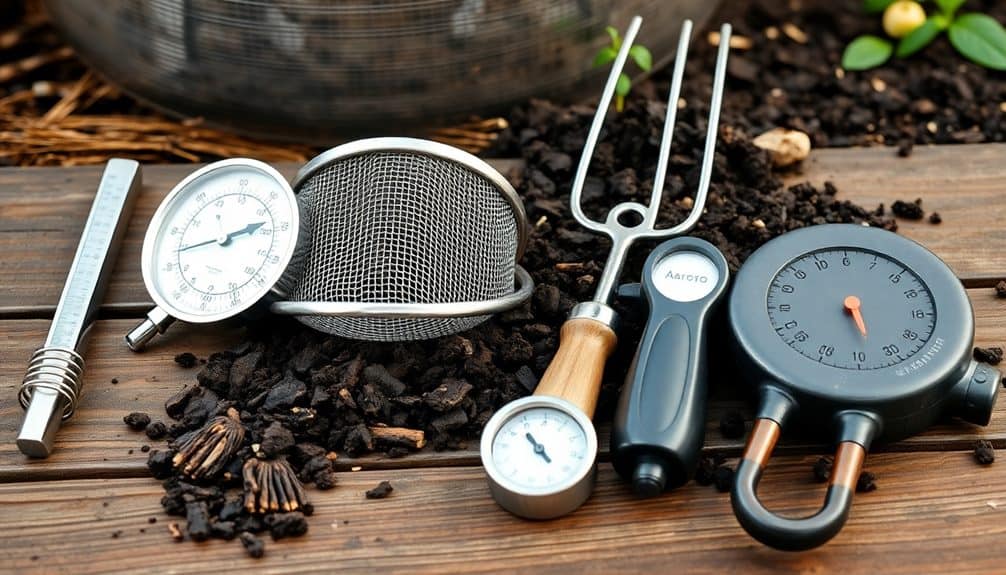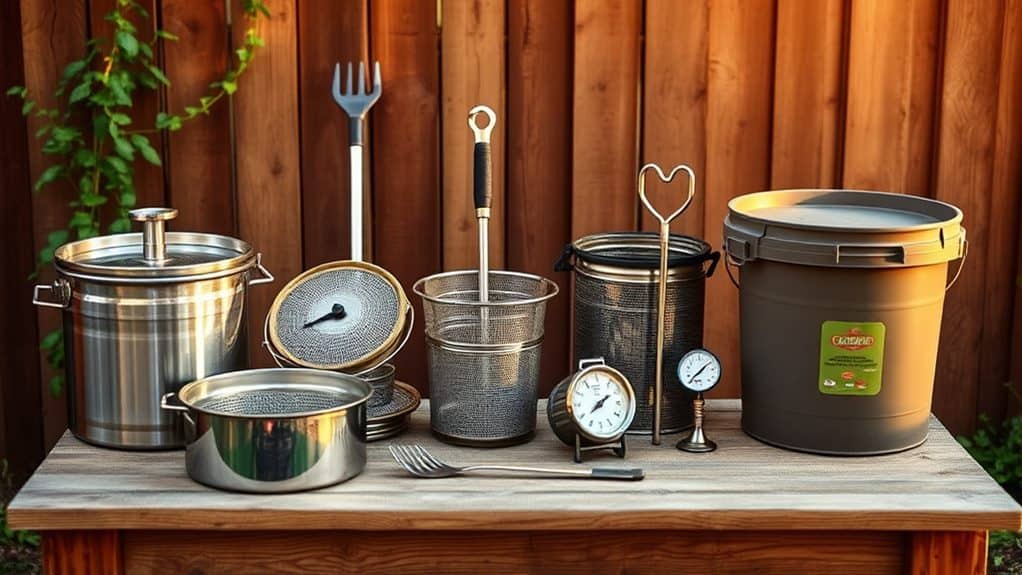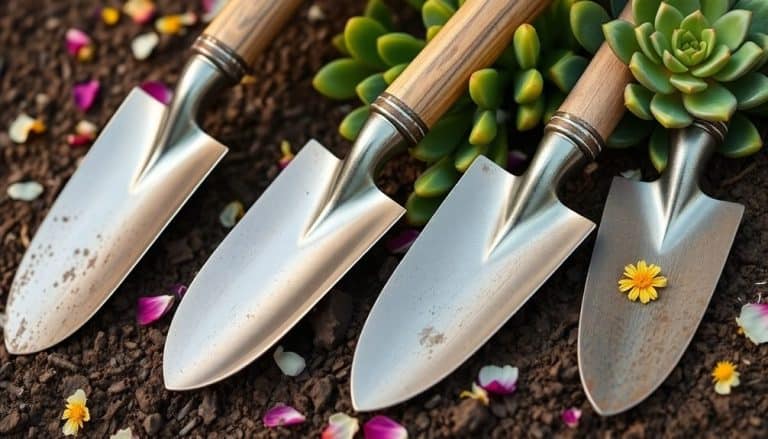This website contains affiliate links. Some products are gifted by the brand to test. As an Amazon Associate, I earn from qualifying purchases. The content on this website was created with the help of AI.
For successful composting in 2024, you’ll want these five essential tools in your gardening arsenal. The Reotemp Backyard Pro 24-inch Compost Thermometer leads the pack with its fog-free dial and precise temperature zones. You can’t go wrong with the 20-inch Reotemp model for smaller piles, while the professional-grade 36-inch version suits larger operations. The 16-inch Thermometer with Temperature Guide offers a budget-friendly option for beginners. To maximize aeration, the EJWOX Compost Aerator Tool‘s innovative corkscrew design makes turning and mixing effortless. Let’s explore how each tool can transform your composting practice into a more efficient and rewarding experience.
Key Takeaways
- A reliable compost thermometer (24-36 inch) with hermetically sealed dial is essential for monitoring optimal decomposition temperatures between 130-160°F.
- Heavy-duty compost aerator with corkscrew design helps efficiently mix materials and maintain proper oxygen levels throughout the pile.
- Durable stainless steel compost sifter separates finished compost from larger materials, ensuring uniform end product quality.
- Weather-resistant compost bin with adequate ventilation holes provides controlled environment for year-round composting and pest prevention.
- Long-handled pitchfork or turning fork allows easy material transfer and pile turning while reducing physical strain during maintenance.
16 Inch Compost Thermometer with Temperature Guide (40-180°F)
- Length: The long stem let you get measurements from all areas of the pile
- Reading: Great for Seeding, Transplanting and Gardening
- Waterproof: Waterproof glass face for easy cleaning, it can be left in the compost pile over night
For gardeners seeking precise temperature control in their composting process, the 16-inch compost thermometer serves as an essential monitoring tool with its wide 40-180°F range and color-coded zones. The heavy-duty stainless steel stem reaches deep into compost piles, while the 2-inch dial displays temperatures in clear 2°F increments.
You’ll find the thermometer’s design includes hermetic sealing to prevent moisture buildup, though some users report fogging issues. The device takes about 30 seconds to provide readings, and it comes with a basic composting guide to help you maintain ideal pile temperatures. While the manufacturer claims a 0.25-inch diameter stem, users note it’s actually smaller at under 3/16 inch. Be aware that some accuracy concerns exist, with reports of temperature discrepancies up to 36°F compared to other thermometers.
Best For: Gardeners and composting enthusiasts who need to monitor temperature variations in their compost piles and want a durable, long-reach thermometer with easy-to-read temperature zones.
Pros:
- Long 16-inch stainless steel stem allows for deep temperature readings in large compost piles
- Easy-to-read 2-inch dial with color-coded temperature zones for quick assessment
- Includes helpful composting guide for beginners and temperature maintenance instructions
Cons:
- Some users report significant accuracy issues with temperature readings varying up to 36°F
- Actual stem diameter is smaller than advertised (under 3/16 inch vs claimed 0.25 inch)
- Despite waterproof claims, moisture and fogging can occur inside the dial
Reotemp Backyard Pro Compost Thermometer (24 Inch)
- 24" Stem Length, Rugged All Stainless Steel Construction
- 5/16" Diameter Heavy Duty Stem
- Free Digital Compost Guide Included - Expert instructions on how to get started composting and managing your compost pile for the most efficient...
Serious composters who manage large backyard piles will appreciate the Reotemp Backyard Pro Compost Thermometer‘s 24-inch reach and rugged stainless steel construction. The 5/16 diameter heavy-duty stem easily penetrates deep into your pile, while the 2.5-inch hermetically sealed dial won’t fog up during use.
You’ll find the large dial especially helpful with its clear temperature zones marked as Steady, Active, and Hot. The thermometer’s accuracy has been tested in both boiling water (200°F) and ice water (32°F), ensuring reliable readings for your composting needs. It’s versatile enough to monitor horse manure piles and even check temperatures in baled hay.
The glass lens resists yellowing, and you can adjust the calibration when needed. For easier handling, pair it with Reotemp’s FM-0 or FM-0S probe handles. A free digital compost guide helps you make informed decisions about turning and wetting your pile.
Best For: Serious composters and farmers managing large compost piles, horse manure, or hay bales who need accurate temperature monitoring with deep pile penetration.
Pros:
- Long 24-inch stem reaches center of large compost piles with durable stainless steel construction
- Clear, fog-free 2.5-inch dial with easy-to-read temperature zones
- Proven accuracy with calibration capability and compatibility with probe handles
Cons:
- May be unnecessarily long for smaller backyard composting bins
- Higher price point compared to basic composting thermometers
- Requires careful handling and storage due to length and delicate nature of probe
Reotemp Backyard Compost Thermometer (20 Inch)
- Perfect for the Beginner Composter - Free PDF Digital Compost Guide Included - Expert instructions on how to get started composting and managing your...
- Reotemp - Accurate and durable thermometers since 1965
- Quality Construction - 20 inch length, 1/4" diameter stem, stainless steel construction, hermetically sealed to prevent fogging
Temperature monitoring lies at the heart of successful composting, and the Reotemp Backyard Compost Thermometer stands out as a professional-grade tool for gardeners who want precise control over their decomposition process.
You’ll appreciate this thermometer’s thoughtful design, featuring a 20-inch stainless steel stem with a pointed tip that easily penetrates your compost pile. The large dial displays three temperature zones, helping you quickly assess your pile’s activity level. It takes just 1-2 minutes to get an accurate reading, with precision that varies by only a degree or less.
What sets this thermometer apart is its hermetically sealed construction that prevents fogging and guarantees durability. You’ll also receive a free PDF Digital Compost Guide with expert instructions. The eco-conscious packaging is 100% compostable, printed with soy-based ink, and can be shredded directly into your pile – making it a zero-waste solution for serious composters.
Best For: Serious home composters and gardeners who want precise temperature monitoring to optimize their composting process and achieve faster decomposition.
Pros:
- High-quality stainless steel construction with hermetically sealed design prevents fogging and ensures durability
- Long 20-inch stem with pointed tip allows easy deep pile measurements
- Includes helpful temperature zones on dial and free expert composting guide
Cons:
- Takes 1-2 minutes to stabilize for accurate temperature readings
- Higher price point compared to basic composting thermometers
- Length may be excessive for smaller compost bins or piles
Reotemp Backyard Pro Compost Thermometer (36 Inch)
- 24" Stem Length, Rugged All Stainless Steel Construction
- 5/16" Diameter Heavy Duty Stem
- Free Digital Compost Guide Included - Expert instructions on how to get started composting and managing your compost pile for the most efficient...
Experienced composters will appreciate the Reotemp Backyard Pro Compost Thermometer‘s professional-grade design and accuracy. Built with a 24-inch stainless steel stem and a hermetically sealed 2.5-inch dial, this thermometer won’t yellow or fog up during use. You’ll find it easy to read the temperature zones marked as Steady, Active, and Hot, with measurements up to 160°F.
The BP-F43 model features a heavy-duty 5/16-inch diameter construction and includes an adjustable calibration screw for precise readings. You’ll get a free digital PDF compost guide with expert instructions, and the thermometer’s 500-millisecond response time guarantees quick temperature checks. While it’s designed for larger compost piles, you might want to pair it with Reotemp’s FM-0 or FM-0S probe handles for added protection and easier handling. The unit comes with a one-year limited warranty and maintains a strong 4.7-star rating from users.
Best For: Serious home composters and gardeners who maintain large compost piles and need accurate temperature monitoring with professional-grade equipment.
Pros:
- Durable stainless steel construction with hermetically sealed dial prevents fogging and yellowing
- Long 24-inch stem allows deep temperature readings in large compost piles
- Quick 500-millisecond response time with clear temperature zone readings and calibration capability
Cons:
- Handle attachment sold separately, which may be necessary for comfortable use
- Higher price point compared to basic composting thermometers
- 160°F maximum temperature reading might be limiting for some hot composting applications
EJWOX Compost Aerator Tool for Outdoor Compost Bins
- Speed Your Compost Pile - Using this compost starter can add air to your bin full of grass clippings, leaves, and vegetable scraps for speeding up...
- Corkscrew-Like Design - This compost turner is crafted from sturdy steel with a free spinning hardwood handle, allowing the user to aerate compost...
- Easy to Use - Place the aerator tool end deep into your compost bin and turn the tool, drawing core material to the surface. Repeat several times...
Gardeners seeking an efficient way to aerate their compost will appreciate the EJWOX Compost Aerator Tool‘s innovative corkscrew design. This 23-inch stainless steel aerator with a hardwood handle helps you turn compost without straining your back or shoulders.
You’ll find it’s particularly effective at breaking up clumps and mixing materials in your outdoor bins. The tool’s design allows you to simply insert it into your pile and twist, drawing core material to the surface. At just 1.94 pounds, it’s lightweight yet sturdy enough for regular use.
While most users praise its effectiveness and ease of use, especially those with arthritis, you’ll want to pay attention to the collared joint, as some have reported durability concerns. The aerator works seamlessly with EJWOX bins and tumblers but is compatible with most standard composting setups.
Best For: Home gardeners and composting enthusiasts who want an efficient, low-effort way to aerate their compost bins while avoiding strain on their back and shoulders.
Pros:
- Innovative corkscrew design makes turning compost easier and less physically demanding
- Lightweight yet sturdy construction with stainless steel and hardwood handle
- Particularly helpful for users with physical limitations like arthritis
Cons:
- Some durability concerns reported at the collared joint
- Higher price point compared to basic composting tools
- Limited reach at 23 inches may require additional effort for deeper compost piles
Factors to Consider When Choosing Composting Tools,Composting Thermometers,Compost Sifters

When you’re choosing essential composting tools like thermometers and sifters, you’ll want to evaluate the material quality and durability to guarantee they’ll withstand frequent use in harsh outdoor conditions. Your composting thermometer should offer accurate readings across a wide temperature range, while sifters need appropriate mesh sizes for your specific composting needs. Consider tools with ergonomic features that make them easier to use, and if possible, opt for environmentally responsible materials that align with your sustainable gardening practices.
Material Quality and Durability
The right material quality and durability in composting tools can make or break your gardening success. When selecting your composting equipment, you’ll want to prioritize stainless steel components, as they offer superior resistance to rust and corrosion, guaranteeing your tools maintain their functionality season after season.
For thermometers, look for models with thicker stem diameters of at least 5/16 inch. These robust designs can withstand frequent insertion into dense compost piles without bending or breaking. You’ll also benefit from thermometers with hermetically sealed gauges, which prevent moisture from compromising accuracy and visibility.
Don’t overlook the importance of ergonomic design in your composting tools. Handles made from hardwood or featuring ergonomic grips will reduce strain during repetitive tasks and make your composting routine more comfortable. When it comes to aerators, invest in well-constructed models with efficient corkscrew mechanisms. These designs not only make turning your compost pile easier but also guarantee better aeration with less physical effort. Remember, paying attention to construction quality now will save you money and frustration in the long run.
Measurement Range and Accuracy
Throughout your composting journey, accurate temperature monitoring serves as a cornerstone of successful decomposition. When choosing a compost thermometer, you’ll need to focus on models that cover temperatures between 40-180°F (0-80°C), as this range effectively captures the various stages of composting activity.
For reliable readings, look for thermometers that have been tested against established benchmarks like boiling water or ice water. Some models can show temperature discrepancies of several degrees, which might affect your compost management decisions. You’ll want to select a thermometer with a hermetically sealed dial to prevent moisture from accumulating inside and causing fog that could impact accuracy.
Consider the response time when selecting your thermometer. While some models stabilize within 30 seconds, others might take up to two minutes to provide an accurate reading. To make temperature monitoring more efficient, opt for thermometers with larger dials measuring 2 to 2.5 inches in diameter. These bigger displays often include clear temperature zone indicators, making it easier for you to assess your compost pile’s conditions at a glance and adjust your management practices accordingly.
Size and Length Options
For effective compost monitoring, thermometer length plays an essential role in accessing your pile’s core temperature. When you’re selecting a compost thermometer, you’ll find options ranging from 16 to 36 inches in length, each designed to accommodate different pile sizes and composting setups.
If you’re managing a larger backyard compost system, you’ll want to opt for thermometers with 24-inch or 36-inch stems. These longer options guarantee you can easily reach the center of your pile where the most significant decomposition occurs. The stem’s diameter is another important factor to take into account – you’ll typically choose between 1/4 inch and 5/16 inch options. A wider diameter offers enhanced durability, while a narrower stem might be easier to insert into dense materials.
Remember that your thermometer’s length should match your pile’s depth to get accurate readings from the core, where microbial activity peaks. Don’t just focus on length alone – reflect on how the combination of stem length and diameter will work with your specific composting setup. The right size guarantees you’ll get reliable temperature readings without struggling to insert or remove the thermometer from your pile.
Ease of Use Features
User-friendly features make all the difference when selecting composting tools for your garden. When you’re choosing a compost thermometer, you’ll want to focus on features that enhance your composting experience and make monitoring easier. Look for models with clear, easy-to-read dials that display distinct temperature zones, allowing you to quickly assess your compost’s activity level at a glance.
A hermetically sealed design is essential for preventing moisture buildup and fogging inside the dial, ensuring you’ll always have clear visibility of temperature readings. You’ll appreciate thermometers that come with built-in temperature guides, as they help you understand whether your pile is operating at ideal levels for decomposition. The most practical models feature straightforward designs that don’t require complex operation or maintenance.
For maximum functionality, select a thermometer with a stem length of at least 16 inches. This longer reach lets you measure temperatures deep within your pile without straining or risking damage to the tool. These user-friendly features aren’t just conveniences—they’re essential elements that help you maintain consistent, effective composting practices throughout the seasons.
Environmental Impact Considerations
When selecting composting tools, their environmental impact deserves careful consideration beyond just their functionality. You’ll want to prioritize tools made from sustainable materials like stainless steel and wood, which help reduce plastic waste and promote eco-friendly practices in your composting journey.
Your choice of tools can markedly affect the composting process’s environmental benefits. By using a quality composting thermometer, you’ll maintain ideal temperatures between 130°F and 160°F, which speeds up organic matter breakdown while reducing unwanted odors and pests. This temperature control is essential for maximizing your compost’s efficiency and minimizing its environmental footprint.
Don’t overlook the importance of proper aeration tools. They’re vital for preventing anaerobic conditions that can produce methane, a potent greenhouse gas. By regularly aerating your compost pile, you’ll promote oxygen flow and facilitate proper decomposition, leading to reduced emissions and better-quality compost.
Remember that effective composting tools contribute to broader environmental benefits. They’ll help you create nutrient-rich compost that improves soil health naturally, reducing your reliance on chemical fertilizers and supporting sustainable gardening practices.
Frequently Asked Questions
How Often Should I Turn My Compost Pile During Different Seasons?
You’ll need to turn your compost pile differently based on seasonal temperatures. During summer, turn it every 2-3 weeks to maintain proper aeration and moisture. In spring and fall, aim for every 3-4 weeks. Winter requires less frequent turning, about once every 4-6 weeks, as decomposition slows down. If your pile smells bad or feels too wet, you should turn it more frequently regardless of season.
Can I Compost in Winter Without Temperature Monitoring Tools?
Yes, you can compost in winter without temperature tools, but you’ll need to adapt your approach. To maintain decomposition, keep your pile large (at least 3x3x3 feet), insulate it with straw or leaves, and continue adding a mix of green and brown materials. While you won’t achieve hot composting temperatures, slow decomposition will still occur. You can monitor progress by observing steam on cold mornings and checking the pile’s center warmth by hand.
What Materials Should Never Go Into a Compost Bin?
You’ll want to keep several harmful materials out of your compost bin. Never add meat, dairy, oils, or diseased plants as they attract pests and create unpleasant odors. Avoid chemically treated wood, glossy paper, and colored ink materials. Don’t include pet waste, which can harbor dangerous pathogens. Skip synthetic materials like plastic, glass, or metal. Also, keep citrus peels to a minimum as they can kill beneficial composting organisms.
How Long Does It Take for Kitchen Scraps to Decompose?
Just like a movie’s runtime varies from a quick 90 minutes to an epic 3 hours, your kitchen scraps’ decomposition timeline isn’t set in stone. You’ll notice most scraps break down in 2-4 weeks if you’re maintaining ideal conditions. However, your timeline depends on what you’re composting. Soft items like banana peels and coffee grounds decompose faster, while tougher scraps like celery stalks and citrus rinds need 4-6 weeks to fully break down.
Should I Cover My Compost Pile During Heavy Rainfall?
You’ll want to partially cover your compost pile during heavy rainfall to maintain the right moisture balance. Too much water can waterlog your pile, disrupt decomposition, and wash away essential nutrients. Use a tarp or compost cover that allows some airflow while keeping excess water out. Don’t seal it completely tight – your pile still needs oxygen. If your compost gets too wet, mix in dry materials like leaves or straw.








